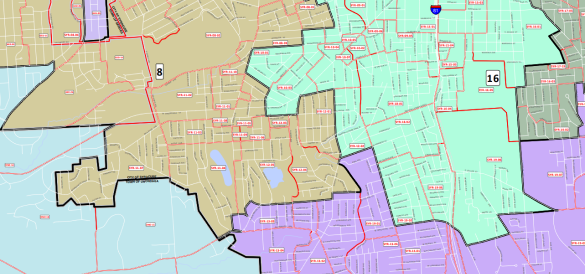An Open Letter to Onondaga County Executive J. Ryan McMahon from Dustin M. Czarny Onondaga County Elections Commissioner (D) Reapportionment Committee Member
Please accept this as my public comment for tomorrow’s hearing as I am unable to attend due to Board duties: Mr. County Executive, I am submitting this written comment in lieu of appearing at the public hearing scheduled for 11 am on Friday. With the election certification process underway, as an elections commissioner for Onondaga County, I cannot take time out of my work day to attend this hearing. I believe many Onondaga County citizens who want to comment on this important decision are in the same situation as me. This is one of the many reasons why I am writing today to urge you to veto the legislative lines passed in a partisan manner that sit on your desk today. The people of Onondaga County deserve better than the maps that were produced in this flawed and rushed process. For three years, the people of Onondaga County have been asking for a more transparent and less partisan redistricting process that will result in fair maps. They petitioned the Onondaga County Legislature and City of Syracuse Common Council in 2019 to replace their partisan processes and put citizens in charge of truly independent redistricting commissions. The City of Syracuse and an overwhelming majority of the County legislators promised to do so. The City of Syracuse fulfilled their promise; however, the Onondaga County Legislature did not enact meaningful legislation to reform the redistricting process. This inaction set up our county to repeat the past mistakes and deliver a flawed potentially illegal product. The Onondaga County Legislature and chairman of the County reapportionment committee compounded that mistake by choosing to rush the current process, effectively prohibiting the community input, in-depth analysis of demographic and voting data, and public scrutiny required to yield a fair map. This rush was entirely unnecessary. The County Charter clearly states the legislature could take up to six months after the delivery of data from the decennial Census to appoint the members of the commission. Instead, the legislature chose to initiate the Commission within a month and provided only 72 hours to find commissioners willing to serve. The County Charter clearly gives the reapportionment commission 3 months to redraw the lines. The Chair of the commission unilaterally demanded the work be done in less than a month. The County Charter allowed the legislature 3 months to then consider the maps. The County Legislative Chairman once again decided to accelerate the process calling a special session of the legislature 10 days after receiving the maps forcing a party line vote to approve them. This rushed process is entirely unnecessary because no map adopted by the Commission will take effect before the 2023 election cycle. Throughout this entire rushed process, the public has been united in calling for more time and a bi-partisan resolution to this important 10-year decision. The failure to heed their warnings has resulted in a flawed map that divides communities and fails to consider the impact on the voting strength of communities of color, quite possibly in violation New York state law and the federal Voting Rights Act. The Commissioner failed to give the public adequate time to review and analyze the maps, let alone an opportunity to provide the kind of thoughtful feedback this weighty process demands. Two public hearings were held before any draft maps were even released. The other three public hearings were held within 72 hours of their release. During this time the Redistricting Commission’s chair, Mr. Hulslander, could not meet even his own deadlines for releasing the maps. Despite an agreement to release the data underlying each map at least 24 hours before the October 27th Committee meeting, the Republican Commissioners did not release their map until just 90 minutes before and even then the data was incomplete. For the November 3rd voting meeting Mr. Hulslander set a deadline of Friday October 30th at noon for final maps. This was just two hours after the final public hearing. Even so Mr. Hulslander once again failed to meet his own deadline as the GOP continued to change the data underlying their map until hours before the November 3rd meeting. This failure to adhere to even their own rushed deadlines—let alone objectively reasonable deadlines—kept the public from having an opportunity to weigh in and point out flaws that need to be addressed. The Reapportionment Commission and Legislative leadership made no attempt to negotiate or compromise their proposed maps to accommodate input from Democratic Commissioners or the public. The map that sits before you today is not substantially changed since it was initially introduced on October 27, in spite of the overwhelming criticism from the public hearings. The maps submitted by the Democratic Commissioners, Sharon Moran and myself, were offered as a first draft meant to be altered and negotiated in response to feedback from other commissioners and the public with the intent of reaching a compromise, consensus map. We asked for more time to get more public input. We were refused. We asked for actual negotiations between commission members on a compromise map. We were refused again. We believe, and still do, that a negotiated map that reflects the equal participation of all commissioners participate and, most importantly, addresses the need and concerns of the community will be a better path forward than adopting this clearly flawed map. City of Syracuse Legislative Map Onondaga County Legislative Map This map is flawed. Inside the City of Syracuse, this map cracked the only majority-Black district in the County Legislature into white-plurality districts without any explanation. This map pairs city districts in 7 & 17 with portions of Dewitt reducing the opportunity for minority representation and needlessly dividing both City and Dewitt communities. This map pairs inner city districts with the Town of Geddes in district 8. District 15 connects the valley of Syracuse with the University and Westcott neighborhoods, communities that have little in common. They create an essentially new inner city district in 9 connecting the little Italy section of the North side









